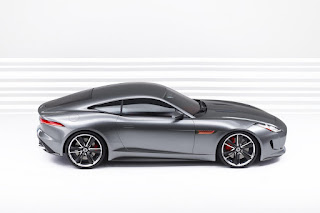Built as a true driver's sports car, the strictly two-seat C-X16 is the smallest Jaguar in terms of length since the 1954 XK120. The concept is built around a shortened version of the next generation XK's aluminium chassis structure and it measures 4,445 mm (175-in.) in length, 2,048 mm (80.6-in.) in width and 1,297 mm (51-in.) in height and has a wheelbase measuring 2,622 mm (103.2-in.).
Lurking under its long hood is hybrid powertrain that includes a next-generation 3.0-liter supercharged V6 petrol engine delivering 380-horses (280kW) and 332 lb ft (450 Nm) of torque and an electric motor generator integrated into the eight-speed automatic gearbox that transfers power to the rear wheels.
The electric motor draws power from a 1.6kWh battery pack mounted behind the seats that is charged through a brake energy regeneration system. The motor provides and additional 95-horsepower (70 kW) and 173 lb ft (235 Nm) of torque.
A Formula 1 Kinetic Energy Recovery System (KERS)-inspired hybrid boost system with a steering-wheel mounted button allows for on-demand acceleration using the electric motor.
Jaguar says the C-X16 tips the scales at 1,600kg (3,527 lbs) and has a perfect 50-50 weight distribution. According to the company, it is capable of accelerating from 0 to 62 mph (100km/h) in 4.4 seconds and from 50 to 75 mph (80-120km/h) in 2.1 seconds, while reaching a top speed of 186 mph (299km/h).
In addition, the British firm reveals that the C-X16 is able to travel at speeds of up to 50 mph (80km/h) using electric power alone and has CO2 emissions of 165 g/km.
The styling of the C-X16 is the work of Ian Callum. The exterior design mixes styling cues from both the XK (up front) and Jaguar's well received C-X75 hypercar study (at the back) from last year's Paris Auto Show, in a more compact form.







































